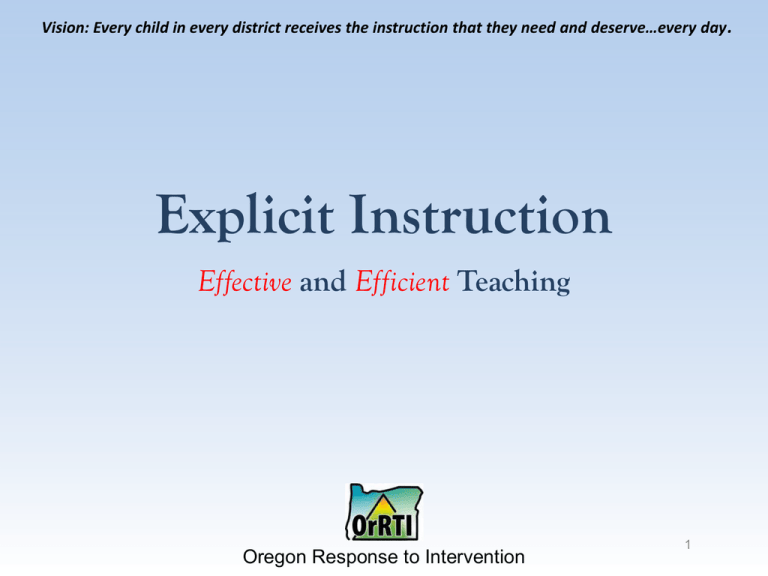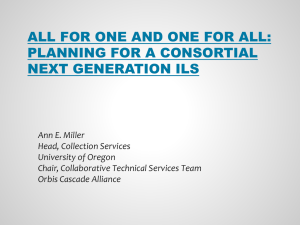Explicit Instruction - Effective and Efficient Teaching
advertisement

Vision: Every child in every district receives the instruction that they need and deserve…every day. Explicit Instruction Effective and Efficient Teaching Oregon Response to Intervention 1 Turn right at the BIG Y Targets • Create excitement and urgency for refining practice of teaching using explicit instruction • Build a community of teachers to support one another in implementing effective, efficient teaching practices • Provide opportunities to discuss what does learning look like, sound like? • What are kids saying? Teachers? Administrators? Oregon Response to www.oregonrti.org Acknowledgements • Content was based on the work of… –Dr. Anita Archer –Dylan Willam –The Consortium on Reading Excellence, Inc. (CORE) –John Hattie What is Explicit Instruction? • Explicit instruction is a systematic instructional approach that includes a set of delivery and design procedures derived from effective schools research………. Ideas that Work • …unambiguous and direct approach to teaching that incorporates instruction design and delivery. Archer & Hughes, 2011 5 Oregon Response to www.oregonrti.org Teacher ratings and student growth Reading Mathematics 0.6 Teacher value-added 0.4 0.2 0 -0.2 -0.4 -0.6 Unsatisfactory Basic Proficient Distinguished impacts student WhichWhat ones make sense? Whichachievement? ones are surprising? Effective teaching Effect variables size Other variables Effect size Formative Evaluation +0.90 Socioeconomic Status +0.57 Comprehensive interventions for students with LD +0.77 Parental Involvement +0.51 Teacher Clarity Computer based +0.75 instruction* +0.37 Reciprocal Teaching +0.74 School Finances +0.23 Feedback +0.73 Interactions* +0.19 Teacher-Student Relationships +0.72 Family Structure +0.17 Direct Instruction +0.59 Retention -0.16 Aptitude by Treatment John Hattie, Visible Learning, 2009 Explicit Instruction and Discovery Not an either or - but a when. Explicit Instruction Discovery Little or no A great deal of background knowledge background knowledge in the domain History of difficulty, of failure History of success 8 Oregon Response to www.oregonrti.org Differences Learning to Read Population Journey to Reading Instructional % Requirements Easy: children read Need no formal decoding 5 before starting school instruction 35 Relatively Easy Learn to read regardless of instructional approach 40 Formidable Challenge Need systematic and explicit instruction 20 One of the most difficult tasks to be mastered in school Need intensive, systematic, direct, explicit instruction Oregon Response to www.oregonrti.org Why Explicit Instruction? • ALL students benefit from Explicit Instruction • It is essential for struggling learners • Improve student outcomes, regardless of content area or core program used. Oregon Response to www.oregonrti.org Essential Features of Systematic Instruction 1. Clear expectations about what is to be learned 2. Clarity of presentation (Instructional Delivery) 3. Multiple opportunities for student responses 4. Active monitoring of responses 5. Frequent evaluation and feedback 6. Relentless, practice, practice, practice Christenson, 1989 Oregon Response to www.oregonrti.org Goals for Explicit Instruction: • Provide bell to bell instruction • Select critical, – breaking complex tasks into obtainable pieces • Design organized, systematic, intentional lessons – include an opening, a body, and a closing Oregon Response to www.oregonrti.org Goals for Explicit Instruction: • • • • • Elicit responses Monitor accuracy o Provide immediate feedback Provide judicious practice on skills Promotes positive relationships peers and teachers • Helpful to all learners, absolutely essential for struggling or disadvantaged learners Oregon Response to www.oregonrti.org Instructional Routines • Anita Talk Time • Coffee please answer the following question: – What are essential components for effective and efficient, results driven instruction? (EI) • Cream please answer the following question: • Where/when do you use, see explicit instruction used on your campus? • With extra time switch questions Oregon Response to www.oregonrti.org Power of E to 3! ENGAGE ENERGY EXCITE Oregon Response to www.oregonrti.org What do you bring? Do you recall a time when you had a learning experience like this? • Thumbs Up= YES Oregon Response to • Thumbs Down= NO www.oregonrti.org Video Observation Talk Time • Coffee please answer the following question: – What routines did you notice? • Cream please answer the following question: – What active engagement strategies were utilized? • With extra time switch questions Oregon Response to www.oregonrti.org Essential Features of Systematic Instruction 1. Clear expectations about what is to be learned 2. Clarity of presentation (Instructional Delivery) 3. Multiple opportunities for student responses 4. Active monitoring of responses 5. Frequent evaluation and feedback 6. Relentless, practice, practice, practice Christenson, 1989 Oregon Response to www.oregonrti.org Clarity of presentation • Modeling or demonstrating the skill (I do it) • Providing prompted or guided practice (we do it) • Providing structured partnership (y’all do it) • Providing unprompted practice (you do it) I do, We do, Y’all do, You do Oregon Response to www.oregonrti.org Gradual Release of Responsibility Progression of the Lesson Teacher Responsibility “I do it” Focus Lesson Guided Instruction “We do it” Collaborative “Y’all do it” Independent “You do it” Student Responsibility Fisher, D., & Frey, N. I do it (Model) What it is What it is NOT • Teacher demonstrates, models, explains, and describes thinking in a clear and concise way • Think-alouds • Providing several models • A time to interrogate students about their thinking (guess what’s in the teacher’s brain) • A time to simply “tell” students things (regurgitate info) • A standard posted on the wall that you can just point to Oregon Response to www.oregonrti.org I do it (Examples) • “Watch me. the sounds are /m/, /a/, /n/, so the word is man.” • “The main idea is the most important part the author wants you to remember from a paragraph. So I’m going to read aloud this passage, and at the end of each paragraph, I’m going to stop and ask myself two questions, “Who or what is this paragraph about?” and “What’s the most important thing about the who or what in this paragraph?” If I can answer those two questions, I probably understand the main idea the author wanted me to get out of that paragraph.” Gradual Release of Responsibility Teacher Responsibility “I do it” Focus Lesson Guided Instruction “We do it” Collaborative “Y’all do it” Independent “You do it” Student Responsibility Fisher, D., & Frey, N. We do it What it is What it is NOT • Guided practice through the use of teacher prompts or cues to assist with understanding • Taking students where they are and guiding to next step • A script to read from • Just a repeat of the instructions • Not every day, with every single student Amount of “We do it” is what varies most depending on the needs of the learner Oregon Response to www.oregonrti.org We do it (Examples) • “Let’s do it together now. Follow along with me as I point to each sound and blend the word. The sounds are /m/, /a/, /n/, so the word is man.” • “Now, for the next couple of paragraphs, you’re going to help me figure out the who or what of each paragraph and the most important thing about the who or what of each paragraph.” Read aloud the next couple of paragraphs, stopping to get responses from students. Gradual Release of Responsibility Teacher Responsibility “I do it” Focus Lesson Guided Instruction “We do it” Collaborative “Y’all do it” Independent “You do it” Student Responsibility Fisher, D., & Frey, N. Y’all do it (check understanding) What it is What it is NOT • Small groups of 2-5 students working together (heterogeneous) • Students consolidate their thinking and understanding • Interact and negotiate their understanding with peers • Individual accountability • Not time to introduce new information to students • Not simply group work where one group product is produced • Not ability grouping Oregon Response to www.oregonrti.org Y’all do it (Examples) • “Now, for the last couple of paragraphs, you’re going figure out the who or what of each paragraph and the most important thing about the who or what of each paragraph., with your elbow partner. Partner 1 you will start by telling your partner, The who or what in this paragraph is… Partner 2, you will then tell your partner, The most important thing about that who or what is… “ Gradual Release of Responsibility Teacher Responsibility “I do it” Focus Lesson Guided Instruction “We do it” Collaborative “Y’all do it” Independent “You do it” Student Responsibility Fisher, D., & Frey, N. You do it (assess) What it is What it is NOT • An opportunity for students to apply what they have learned • Goal of schooling • Based on meaningful learning activities • Students take responsibility for own learning • A pile of worksheets or packets • Rote memorization or regurgitation time • For newly or barely learned tasks Oregon Response to www.oregonrti.org You do it (Examples) • “Now, on your own, you will read this 3 paragraph story and for each paragraph, you will write down: 1. Who or what the paragraph is about. 2. The most important thing about the who or what” Gradual Release of Responsibility Teacher Responsibility “I do it” Focus Lesson Guided Instruction “We do it” Collaborative “Y’all do it” Independent “You do it” Student Responsibility Fisher, D., & Frey, N. Clarity of presentation • Modeling or demonstrating the skill (I do it) • Providing prompted or guided practice (we do it) • Providing structured partnership (y’all do it) • Providing unprompted practice (you do it) I do, We do, Y’all do, You do Oregon Response to www.oregonrti.org Essential Features of Systematic Instruction 1. Clear expectations about what is to be learned 2. Clarity of presentation (Instructional Delivery) 3. Multiple opportunities for student responses 4. Active monitoring of responses 5. Frequent evaluation and feedback 6. Relentless, practice, practice, practice Christenson, 1989 Oregon Response to www.oregonrti.org Be explicit! Don’t let them get lost! Now...let’s see it in action! Oregon Response to www.oregonrti.org Now...let’s see it in action! Oregon Response to www.oregonrti.org Welcome Back! Time to Share with Peers Step 1. • Grab your demo lesson card • Go to an assigned corner with your card • Four Corners – Primary K-1 – Primary 2-3 – Intermediate – Instructional Leaders Oregon Response to Step 2. • Share with at least two people new to you • Introduce yourself • Coffee share one idea from your demonstration lessons observation • Cream share one idea • Move on to new person Ten minutes for each sharing session (5minutes each to speak) www.oregonrti.org Welcome Back Time to Share with Peers Step 1. • Grab your demo lesson card • Go to an assigned corner with your card • Four Corners – – – – Primary K-1 Primary 2-3 Intermediate Instructional Leaders Oregon Response to Step 2. • Share with at least two people new to you • Introduce yourself • Coffee share one idea from your demonstration lessons observation • Cream share one idea • Move on to new person Ten minutes for each sharing session (5minutes each to speak) www.oregonrti.org See you in 15 minutes! Oregon Response to www.oregonrti.org Welcome Back Oregon Response to www.oregonrti.org Where You’ve Been • You have developed conceptual understanding of: – The Big Five, Active Engagement, Explicit Instruction, • You have had active participation with peers and processing time • You have seen demonstration lessons Oregon Response to www.oregonrti.org Where You’re Going • We will continue to build on your conceptual understanding and build skill development in feedback. • We will close the day with a call to action! Math, OTR, CCSS Oregon Response to www.oregonrti.org The Essentials of Feedback • Feedback – can double the rate of learning •Dylan William (2011) – has an effect size of .79 •Hattie (2012) – informs current level of performance – closes the gap between current performance and expected performance – must give specific ways to close the gap Oregon Response to www.oregonrti.org How do you receive feedback??? • One minute quick write – At work, at home, at the gym, on the field...from friends... – Circle one area where it was helpful Oregon Response to www.oregonrti.org Talk Time • Coffee please answer the following question: – How was the feedback helpful? • Cream please answer the following question: – Where/when do you provide feedback? • With extra time switch questions Oregon Response to www.oregonrti.org The missing element re: instructional Improvement? ACTIONABLE FEEDBACK “Feedback is the breakfast of champions!”Kevin Feldman 7 Keys to Effective Feedback 1. 2. 3. 4. 5. 6. 7. Goal Referenced Tangible and Transparent Actionable User-friendly Timely Ongoing Consistent • Grant Wiggins (EL, 2012) Oregon Response to www.oregonrti.org 7 Keys to Effective Feedback 1. 2. 3. 4. 5. 6. 7. Goal Referenced Tangible and Transparent Actionable User-friendly Timely Ongoing Consistent • Grant Wiggins (EL, 2012) Oregon Response to www.oregonrti.org Provide scaffolding that enhances success 53 Oregon Response to www.oregonrti.org Call to Action! • Application Cards Activity (Real World Application of learned material) – Prompt: • With the information I received today I commit to_____________, by_______________ with_____________. I will need______________ to help me successful. • Respond to the prompt on a piece of paper. Five minutes to respond. Oregon Response to www.oregonrti.org Call to Action • Whip- table share, 10 minutes • Discuss as a table team 10 minutes • Choose one person to be prepared to share with the group • Group share Oregon Response to www.oregonrti.org Prizes Oregon Response to www.oregonrti.org Prizes Oregon Response to www.oregonrti.org







